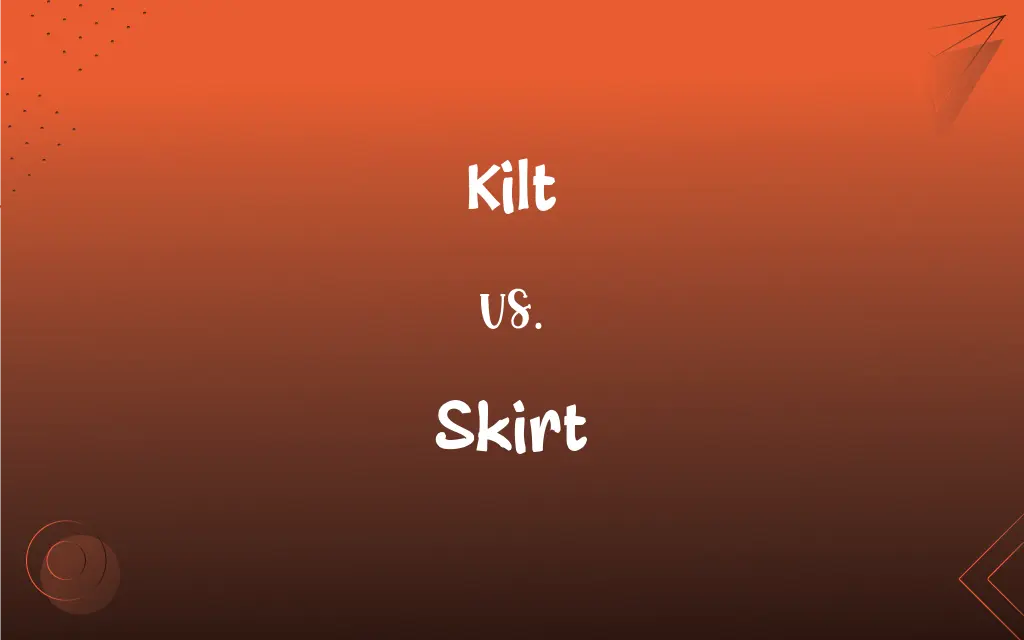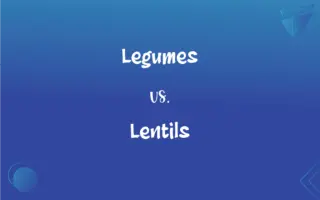Kilt vs. Skirt: What's the Difference?
Edited by Janet White || By Harlon Moss || Updated on October 12, 2023
A kilt is a knee-length non-bifurcated skirt-type garment with pleats, traditionally worn by men in Scotland. A skirt is a waist-down garment hanging from the waist, typically worn by women, without cultural specificity.

Key Differences
A kilt is a distinct garment most recognized as a symbol of Scottish heritage, enveloping the wearer in a swath of pleated fabric, typically made from wool. Conversely, a skirt spans multiple cultures and periods, often adopted as a versatile piece in women’s fashion without a precise cultural emblem.
Historically, the kilt serves not just as a garment but also a canvas to display particular tartan patterns, which are often associated with Scottish clans or regions. Whereas the skirt doesn’t normally carry such specific regional or familial connotations, offering a vast palette of designs, materials, and styles unrestricted by such affiliations.
The kilt is entrenched in a masculine context, traditionally being a male garment, and often presents a solemn or formal aesthetic. In contrast, the skirt is generally associated with femininity, offering an array of options from casual to formal, without being rooted in a singular, gendered tradition.
Observing practicality, a kilt is often perceived and utilized as formal wear, worn at events such as weddings or ceremonies, symbolizing a respect for tradition. Meanwhile, skirts maintain a flexible position in the wardrobe, being adaptable to various occasions, from daily wear to special events, absent of the ceremonial gravity often ascribed to kilts.
Focusing on the global perception and adaptation, the kilt, while globally recognized, is predominantly worn and produced in Scotland and, to a lesser extent, other Celtic regions. Contrarily, the skirt is a global garment, found in myriad forms across various cultures, countries, and fashion trends, bearing a universal appeal and adaptation.
ADVERTISEMENT
Comparison Chart
Cultural Significance
Deeply rooted in Scottish tradition.
Universally present, no specific cultural tie.
Typical Wearers
Traditionally worn by men.
Predominantly worn by women.
Design Elements
Characterized by pleats and specific tartan patterns.
Can come in various styles, patterns, and materials.
Occasion Suitability
Often worn for formal and ceremonial occasions.
Suitable for both casual and formal occasions.
Global Adoption
Primarily associated with Scotland and Celtic traditions.
Widely adopted and adapted globally.
ADVERTISEMENT
Kilt and Skirt Definitions
Kilt
Kilts often feature pleats, organized folds that add structure and movement.
The pleats in his kilt swayed as he performed the traditional dance.
Skirt
A skirt is a garment hanging from the waist, often extending to the knees or below.
She chose a knee-length skirt for the casual outing.
Kilt
The kilt is worn at the natural waist and hangs to around knee length.
His kilt, sitting at his waist, showcased the detailed work of the fabric.
Skirt
Skirts often come in assorted patterns, such as floral, striped, or solid colors.
The floral skirt added a splash of color to her spring outfit.
Kilt
A kilt is a traditional Scottish garment, often in a specific tartan pattern.
The man wore a kilt in his clan’s tartan to the Highland games.
Skirt
Skirts can be found in a variety of styles, such as A-line, pencil, or pleated.
The pleated skirt moved gracefully as she twirled.
Kilt
Kilts are usually paired with knee-high socks and sometimes a small dagger (sgian-dubh).
His kilt outfit was complete with socks and a ceremonial sgian-dubh.
Skirt
The skirt can be adapted to various occasions, both formal and casual.
She opted for a sleek black skirt for the formal event.
Kilt
A kilt often carries a sporran, a small pouch worn at the front.
He stored his phone and wallet in his kilt’s sporran.
Skirt
The skirt might be constructed from various materials, including cotton, silk, or denim.
Her denim skirt was a versatile choice for the picnic.
Kilt
A knee-length skirt with deep pleats, usually of a tartan wool, worn as part of the dress for men in the Scottish Highlands.
Skirt
The part of a garment, such as a dress or coat, that hangs freely from the waist down.
Kilt
A similar skirt worn by women, girls, and boys.
FAQs
Are skirts typically made from a specific material?
No, skirts can be made from a variety of materials, including cotton, silk, denim, and more.
Are there ceremonies related to wearing a kilt?
Yes, kilts are often worn during Scottish and Celtic ceremonies and traditions, such as weddings or highland games.
Are skirts and kilts season-specific?
No, both garments can be worn in various seasons, depending on material and accompanying apparel.
Are skirts suitable for all ages?
Yes, skirts are versatile garments worn by people of all ages.
Can skirts be paired with various types of tops?
Yes, skirts can be paired with numerous top styles, ranging from casual t-shirts to formal blouses.
How is a kilt different from a skirt?
Kilts are associated with Scottish heritage, often pleated with tartan patterns, while skirts are more universally worn, without specific cultural or traditional designs.
Can skirts be worn for formal occasions?
Yes, skirts can be suitable for both formal and casual occasions, depending on the style and material.
Is the skirt a gender-specific garment?
Predominantly, skirts are worn by women, but fashion trends and cultural shifts have seen skirts being worn by all genders.
Are certain colors or patterns on skirts culturally significant?
While skirts can feature various patterns and colors, they generally do not bear the same cultural significance as kilts.
Can kilts be worn outside of Scotland?
Absolutely, kilts can be worn anywhere, although they are most commonly associated with Scotland.
Is the kilt considered formal wear?
The kilt is often worn for formal occasions but can also be adapted for casual wear.
What is worn under a kilt?
Tradition often humorously states nothing is worn under a kilt; however, it's usually up to personal preference.
How are kilts and skirts similar?
Both kilts and skirts are non-bifurcated garments that hang from the waist and can be similar in length.
Are all kilts made in Scotland?
While many traditional kilts are made in Scotland, they can be made anywhere.
Can skirts be customized similarly to kilts?
Yes, skirts can be tailored and customized in numerous styles, materials, and lengths, although they may not carry the ancestral significance of kilts.
What is a kilt traditionally made from?
Kilts are traditionally made from woolen cloth in a tartan pattern.
Can women wear kilts?
Yes, while traditionally a male garment, women can and do wear kilts, especially in modern times.
What does the length of a skirt signify?
Skirt lengths can vary and might be chosen for style, comfort, modesty, or to adhere to social norms and trends.
What does the pattern on a kilt mean?
Traditionally, the tartan pattern on a kilt signifies the wearer’s clan or regional affiliation in Scotland.
How do you determine the appropriate skirt length?
The appropriate skirt length can depend on the occasion, personal style, and comfort.
About Author
Written by
Harlon MossHarlon is a seasoned quality moderator and accomplished content writer for Difference Wiki. An alumnus of the prestigious University of California, he earned his degree in Computer Science. Leveraging his academic background, Harlon brings a meticulous and informed perspective to his work, ensuring content accuracy and excellence.
Edited by
Janet WhiteJanet White has been an esteemed writer and blogger for Difference Wiki. Holding a Master's degree in Science and Medical Journalism from the prestigious Boston University, she has consistently demonstrated her expertise and passion for her field. When she's not immersed in her work, Janet relishes her time exercising, delving into a good book, and cherishing moments with friends and family.































































